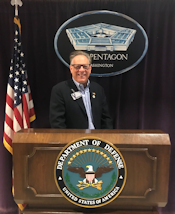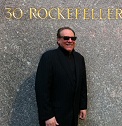In this month’s interview, we talk to Jess Jankowski, President and Chief Executive Officer, and a Board Director of Nanophase. Mr. Jankowski was elected Chief Executive Officer (Acting) in August of 2008 and was elected President and Chief Executive Officer, and Board Director, in February 2009. He joined Nanophase in November 1995. He was elected Secretary and Treasurer in November 1999, Acting Chief Financial Officer in January 2000, Vice President in April 2002, and Vice President of Finance and Chief Financial Officer in April 2004. From 1990-1995 he served as Controller for two building contractors in the Chicago area, during which time he had significant business development responsibilities. From 1986 to 1990 he worked for Kemper Financial Services. Mr. Jankowski holds a B.S. from Northern Illinois University and an M.B.A. from Loyola University. He was elected to the TechAmerica (formerly AeA) Midwest Board in 2008 and was an active member of the TechAmerica Midwest CFO Committee from 2006 through 2008. He was appointed to the NanoBusiness Advisory Board in 2009. Mr. Jankowski was appointed to the Romeoville Economic Development Commission in 2004 and served in 2010. He has also served on the Advisory Board of NITECH (Formerly WESTEC), an Illinois Technology Enterprise Center focusing on the commercialization of advanced manufacturing technologies from 2003 to 2008. In 2009, Mr. Jankowski was appointed to the Board of Directors of the Northern Illinois Technology Foundation, an economic development and technology transfer entity that is part of Northern Illinois University.
In our interview, we discuss the current state and outlook for innovative nanomaterials. We hope you enjoy the interview with Jess Jankowski. -Steve Waite, Director of Research and Strategy, The NanoBusiness Commercialization Association
SW: Thanks for taking the time to speak with us, Jess. Nanophase has been in business for quite some time. Give us a little background of how the company got started, how it has evolved, and what its mission is today.
JJ: Nanophase is built from an idea that grew out of the Argonne National Laboratory – the ability to make pure metal oxide particles for particular applications at the nano scale. Often, manufacturers are forced to use materials with impurities or with secondary structures that don’t provide the effectiveness they are looking for. With this technology, we can provide metal oxides to manufacturers in any form (dry powder, dispersed in liquid, or dispersed into a plastic flake that is ready to use in their process) with the desired attributes ranging from particle size and shape to particular surface chemistries. It was a better way to provide manufacturers with materials they needed.
SW: What are the primary nanomaterials produced by Nanophase and why is the company focused on those materials?
JJ: The most popular is nano zinc oxide used in personal care applications (such as sunscreens for sensitive skin). Zinc oxide is an excellent, all natural, full spectrum UV ray absorber. Using nano zinc oxide allows that glob of white cream that we used to see decorating so many lifeguard’s noses to be clear today. Zinc oxide is gentler on the skin than many of the organic chemicals used to achieve the same purpose, so we have noticed an uptick in use in both sensitive skin sunscreen applications as well as certain daily wear cosmetics. Our material is also considered an “all-natural” or mineral-based product, which resonates with quality conscious consumers. Just as zinc oxide protects human skin, it also is effective in certain UV protection applications such as for exterior coatings (paints and stains) and many other applications.
Beyond zinc oxide, we have developed a family of aluminum oxide additives to impart a thin layer of scratch resistance to high-end packaging, signage, and consumer electronics products. We also use cerium oxide for polishing applications, from semiconductor and other electronics applications through architectural window solutions. We typically sell chemical additives, but our polishing expertise allowed us to launch our first complete product line for window polishing and restoration under the NanoUltra™ family of products. These are the most common products we sell, but we also sell smaller amounts of several other metal oxides for particular applications. We have a very flexible manufacturing platform that allows us to pursue markets broadly.
SW: There are numerous applications for nanomaterials in the 21st century. Tell us about the applications Nanophase is currently targeting in the market.
JJ: Several areas where we see significant opportunities in the near term are natural UV protection in personal care (e.g., sunscreens and daily wear cosmetics), providing scratch resistance in transparent coatings, UV-resistance in architectural coatings and a series of other applications that are too early-stage to mention. We fully understand that we will increase and decrease our focus in various markets as we grow and gain more commercial feedback. The underlying need for both transparent functional coatings and well-dispersed active materials provides us with more opportunities than we can possibly address simultaneously. For now, focus is the key!
SW: What are the major advantages to a sunscreen product that is produced with your nanomaterials?
JJ: Our nano zinc oxide provides a terrific combination of being very effective while gentle. Unlike many solutions on the market, nano zinc oxide is a full spectrum UV blocker, meaning that it minimizes the effects of UVA and UVB radiation very well. Many products have historically focused on UVB for blocking sunburn, without paying as much attention to UVA, which relates to cellular degradation and skin cancer. New label requirements in Europe, and likely soon to be in the United States (maybe this year), will require this be better disclosed, and you’ve likely already seen products on the shelves that are dealing with these disclosures. Sunscreens with our materials are designed to be long lasting, even when used in water. And zinc oxide tends to be gentle on the skin, more so than many of the organic chemicals commonly used. These reasons explain why our products are often found in sensitive skin products, and also explain why we are a natural choice for daily wear cosmetics.
SW: Please tell us more about the transparent UV resistant coatings for wood that Nanophase is developing. What are its advantages relative to existing products on the market?
JJ: The most effective wood coatings today tend to rely on heavy pigments to achieve UV protection, so that the wood will often look red or orange depending on the pigment being used. There’s nothing wrong with those colors, but many would prefer the natural look of their wood and simply want it to last longer. We have seen that our nanomaterials can improve the effectiveness of coatings significantly, particularly in the transparent and lighter-pigmented semi-transparent applications. We are working with customers to take the basic technology to market in both semi-transparent and completely transparent wood coatings. This is an area where we hold a significant advantage over the tradeoffs that historically had to be made – protection vs. transparency. Our solutions offer the market both.
SW: What are some of the futuristic nanomaterials applications Nanophase is working on that you can share with us?
JJ: Working at a small scale with significant control over the particles has provided potentially huge energy applications that we are working on, although it will take some time to determine viability. Very thin, transparent coatings also present strong potential advantages in plastics applications. We have recently devised a method for adding our materials into several traditional plastics fabrication processes, and are working with alpha customers on different applications. Either of these concept areas could launch a company today, but we are looking at them as additional areas for the strategic growth of our company, which already has a good history and understanding in creating and then manufacturing these solutions.
SW: Do you sense there is a misconception today among policymakers, companies, and the general public about nanomaterials?
JJ: The unknown is inherently scary. People who don’t know what we do often assume that we are making little robots that will take over the world, or unstoppable microbes. What we are really doing is improving the forms, or formats, of materials that have been used for a very long time. The data we see supports the safety of our products, and we believe we meet every available standard of safety in our manufacturing processes. I can only address our products – many companies are creating products at a nano scale for all sorts of applications today that I’m less familiar with, and I’m sure some will have issues and others won’t, just like any other business segment. I believe we’re seeing a softening of this paranoia in the marketplace and in legislative circles.
SW: What kind of testing has Nanophase been involved with over the past decade – either directly or indirectly – with its nanomaterials and what are the results of those tests?
JJ: This is a broad topic that I won’t try to address completely. I think the best way might be to discuss how we at Nanophase handle our Environmental Health and Safety (“EH&S”) program. Given that there aren’t specific rules regarding the evaluation of nanomaterials in the workplace, we have adopted and enhanced the existing safety regimes commonly and effectively used in the chemical industry. We rely on NIOSH and OSHA standards as the starting point for our EH&S program. To their requirements (compliance to chemical exposure rules and Permissible Exposure Limits or “PEL”), we have added a combination of additional tools and techniques to assess, control and monitor exposure to nanomaterials in the workplace. We measure fugitive emissions regularly and, in most cases, measured particulate levels are between one 1% and 5% of the established “PEL” by OSHA. Keep in mind that this standard includes both total and respirable dust. Many of the minimal particulates counted are generated by non-production (meaning, non-nanomaterial) processes. Our results also regularly show that the particle counts inside the production areas are measured lower than the particles present in the outdoor environment, including in the parking lot of the fast food restaurant down the street!
Lastly, on an annual basis, Nanophase executes a facility wide medical evaluation for production, quality, engineering, and R&D employees. The evaluation consists of a medical questionnaire, a pulmonary function test, and a follow-up physical if a need is determined by the company’s physician. The purpose of this evaluation is to monitor and respond to any decline in pulmonary function and to check for any other medical condition related to a single employee or pool of employees. Over the past five years (where our date is readily available), not a single employee has shown a decline in their medical condition that can be related to workplace exposure. I’m proud of our record, I’m proud of our EH&S team, and we continue to focus on strengthening our program whenever we determine additions can be helpful.
SW: Outside of the United States, what other countries are heavily engaged in nanomaterials research and development and how much innovation are we seeing in those countries?
JJ: This is a significant area of concern. The United States has enjoyed being a technology leader for decades. This is changing. Education and employment opportunities outside the United States have been improving at a much faster clip than domestically. Nanotechnology remains largely a “basic science” application, and fewer people are willing to put money behind learning about how things work. This is likely going to get far more imbalanced over time, as other nations promote technologies that will enable the next generation of products, while we struggle with fiscal challenges. While we often compete against non-nano technologies, we see that our most direct competitors are already located outside the United States.
SW: One last question for you, Jess. China moved to restrict its exports of “Rare Earth” minerals. What kind of impact do you think this will have on the nanomaterials business in the future?
JJ: We vaporize metal, so commodities are our raw materials. “Rare Earths” are a classification of materials often used in high end electronics. One member of that class is the cerium oxide we sell for polishing applications. As 97% of Rare Earth materials are exported from China today, the severe export restrictions imposed during 2010 are having a dramatic impact on the market. Many companies can’t get the material they need, and those which have been able to do so, like Nanophase, must pay significantly more than they did a year ago. This hurts our customers, and over time will drive changes in methods and products. We are working very closely with our customers on managing these issues, but they are significant. Our investment in inventory has skyrocketed because our customers need this material. New sources of supply are opening around the world during 2011, 2012, and beyond, but this will remain a significant challenge to many high-tech industries for the foreseeable future.
There are two mitigating bright spots here:
1) Cerium oxide to allow results to be achieved that are not possible with other materials today, so demand will continue to some extent; and
2) Smaller materials achieve greater functionality “per pound” than larger materials and, therefore, inherently require smaller quantities of materials to achieve a given performance level. This reduces both cost and, ultimately, offers greener alternatives in some cases where fewer byproducts are created for a given process.
SW: Thanks again for your time, Jess. It has been a pleasure speaking with you. We wish you and your colleagues at Nanophase all the best in the future.
You will be able to hear Jess live and in person at our 10th Annual Event.
PLEASE SAVE THE DATE for our 10th Annual NanoBusiness Conference/Nanomanufacturing Summit 2011
September 25-27, 2011
Boston, MA
http://www.internano.org/nms2011/
REGISTER TODAY
Industry/Government:
$400.00; $500.00 after August 26, 2011
University/Academia:
$200.00; $250.00 after August 26, 2011
https://regstg.com/Registration/RegForm.aspx?rid=9363e8fe-34c5-4188-9ecb-f1a5852ef5f3
Seaport World Trade Center, Boston, MA
http://www.seaportboston.com/meetings-and-events/overview.aspx
Hotel: Seaport Hotel (connected to the World Trade Center)
http://www.seaportboston.com/
Regards,
Vincent Caprio “Serving the Nanotechnology Community for Over a Decade”
Executive Director
NanoBusiness Commercialization Association
203-733-1949
vincent@nanobca.org
www.nanobca.org





